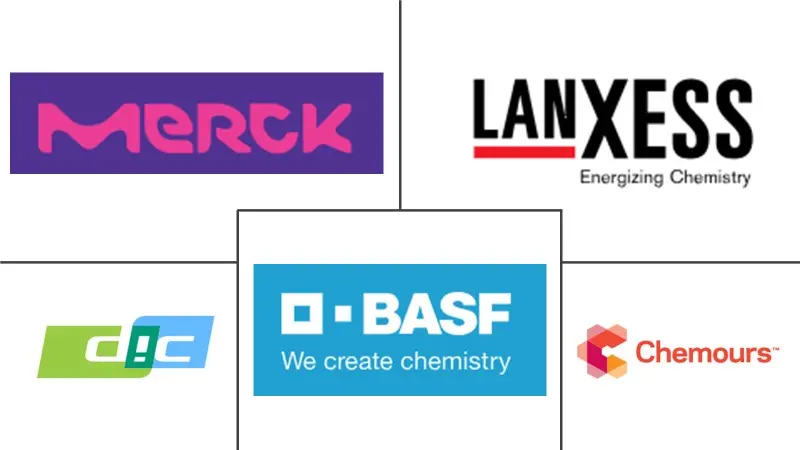Europe Pigments Market Size and Share
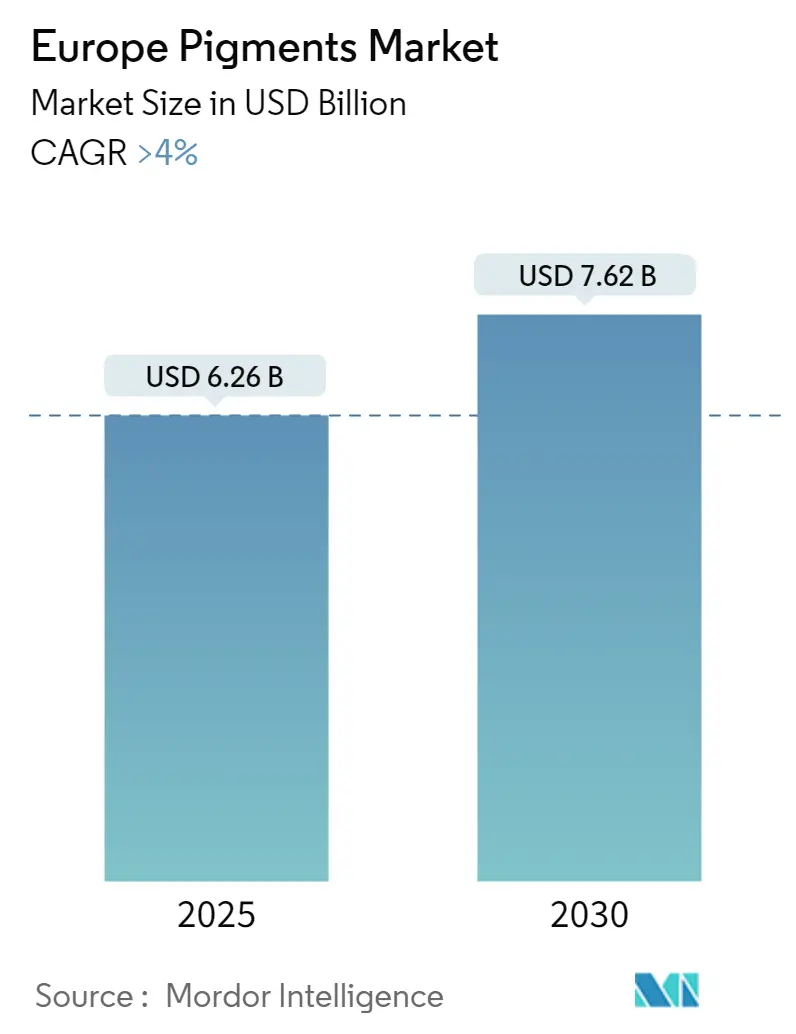
Europe Pigments Market Analysis by Mordor Intelligence
The Europe Pigments Market size is estimated at USD 6.26 billion in 2025, and is expected to reach USD 7.62 billion by 2030, at a CAGR of greater than 4% during the forecast period (2025-2030).
In Europe, countries like Italy and the United Kingdom were worst hit by the COVID-19 pandemic, which negatively affected the market. Paints, coatings and textiles manufacturing activities were temporarily halted due to the pandemic, which decreased the usage of pigments. However, the market recovered well after the restrictions were lifted. The market recovered significantly, owing to the rise in consumption of pigments in paints and coatings, textiles, and printing ink applications.
Over the short term, growing demand from the paints and coatings industry, increasing demand from the textile industry, and the increasing usage of organic pigments in the printing ink industry are expected to drive the market.
The stringent government regulations on the usage of pigments are hindering market growth.
The shifting focus toward eco-friendly products and rising demand for reliable commercial products, like 3D printing material, are expected to create opportunities for the market during the forecast period.
Germany is expected to dominate the market due to the rising demand for pigments in paints, coatings, and textiles applications. It is also expected to register the highest CAGR during the forecast period.
Europe Pigments Market Trends and Insights
Increasing Demand from the Paints and Coatings Industry
- Pigments are majorly used in paints and coatings production. These are engineered, enabling them to withstand challenging demands without compromising the coating performance.
- The United Kingdom and Germany are Europe's largest markets for paints and coatings. The demand for paints and coatings is increasing in the construction and automotive industries in the region.
- The automobile manufacturing industry in Germany is a prominent shareholder of the overall automotive production in the European region. The country hosts major car-making brands, including Volkswagen, Mercedes-Benz, Audi, BMW, Porsche, etc. According to OICA, the total production volume of cars and light commercial vehicles reached 3.67 million units in 2022, compared to 3.30 million units manufactured in 2021, at a growth rate of 11%. Therefore, such growth in the automotive industry has also been driving the region's demand for paints and coatings.
- In the United Kingdom, the paints and coatings industry is rapidly growing. According to the British Coatings Federation, every three out of four cans of paint sold within the United Kingdom are also produced in the country. The country also exports about 30% of all UK-made paints, making the country a net paint exporter.
- Similarly, several companies are increasing the production volume of paints and coatings in the region. For instance, in January 2023, Sherwin-Williams announced its plan to expand the Sheffield paint production facility with an investment of USD 12 million. This facility expansion is expected to increase the capability to service supply to the United Kingdom and European markets. The growth in end-user industries of paints and coatings has been incentivizing paint manufacturers to increase their production, supporting the growth of the market studied.
- Thus, the paints and coatings industry growth is expected to drive the region's pigments market.
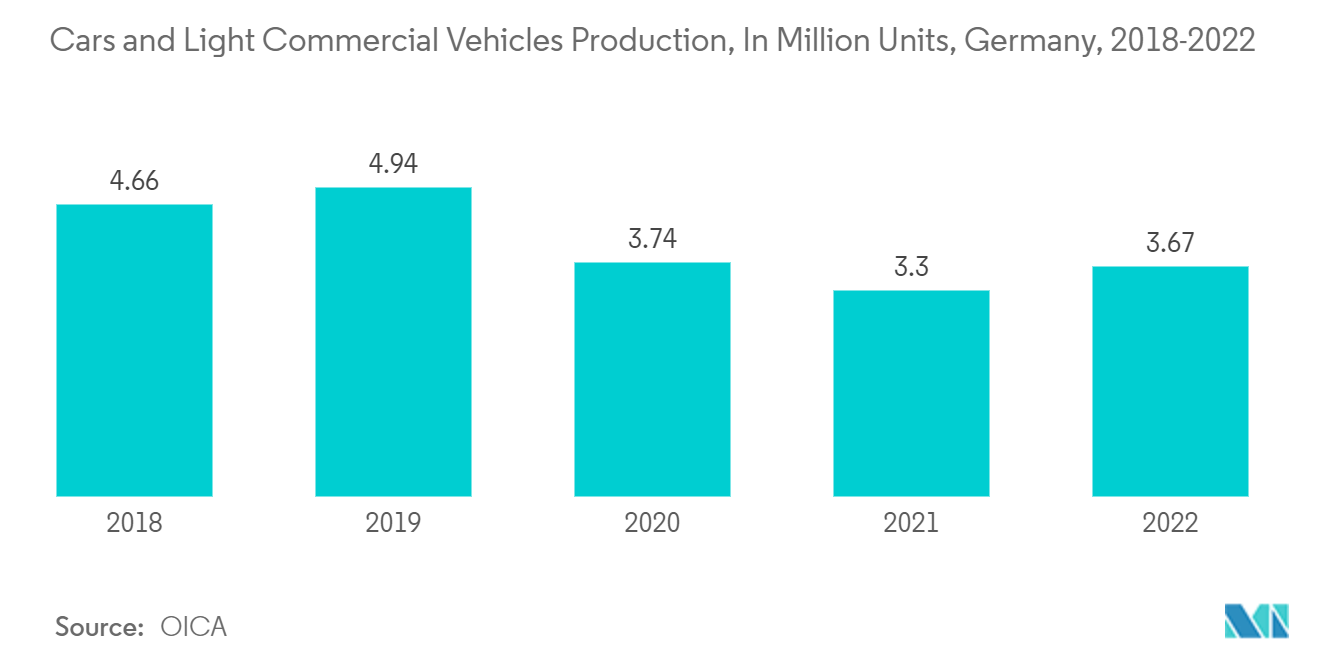
Germany to Dominate The Market
- Germany is one of the significant markets for pigments in the Europe region. Pigments are used in various applications, such as paints, coatings, textiles, leather, printing inks, and plastics. In the construction industry, architectural and decorative coatings account for the enormous consumption of pigments in their production.
- Germany has the most significant construction industry in Europe. The country's construction industry has been growing slowly, driven by increasing new residential construction activities. For instance, according to Eurostat, the building construction revenue was registered at USD 114 billion in 2022 and was expected to reach USD 125.4 billion by 2024. Thus, growth in the construction industry is likely to affect the market for paints and coatings, thereby driving the market for pigments in the country.
- Furthermore, according to the Statistisches Bundesamt, the industry revenue from the manufacture of paints, varnishes, and similar coatings, printing ink, and mastics in the country accounted for USD 12.49 billion in 2020. It was projected to reach around USD 12.94 billion by 2024, thereby likely to increase the consumption of pigments used in the paints and coatings sector, which will further enhance the demand for pigments in the country.
- The German textile industry is the largest in the European region, with around 6000 registered companies. The country is a prominent importer of raw textile materials and exporter of finished textile products. The industry has grown to a gigantic stature, as it caters to 18% of the textile market in Europe.
- In December 2022, Trützschler Card Clothing (TCC) expanded its site in Neubulach, Germany, with an investment of EUR 12 million (USD 13.1 million). The company has expanded its services and production intensity on this site with the enhancement in process flow.
- Overall, the growth of industries such as paints and coatings, textiles will likely drive the market for pigments in the country during the forecast period.
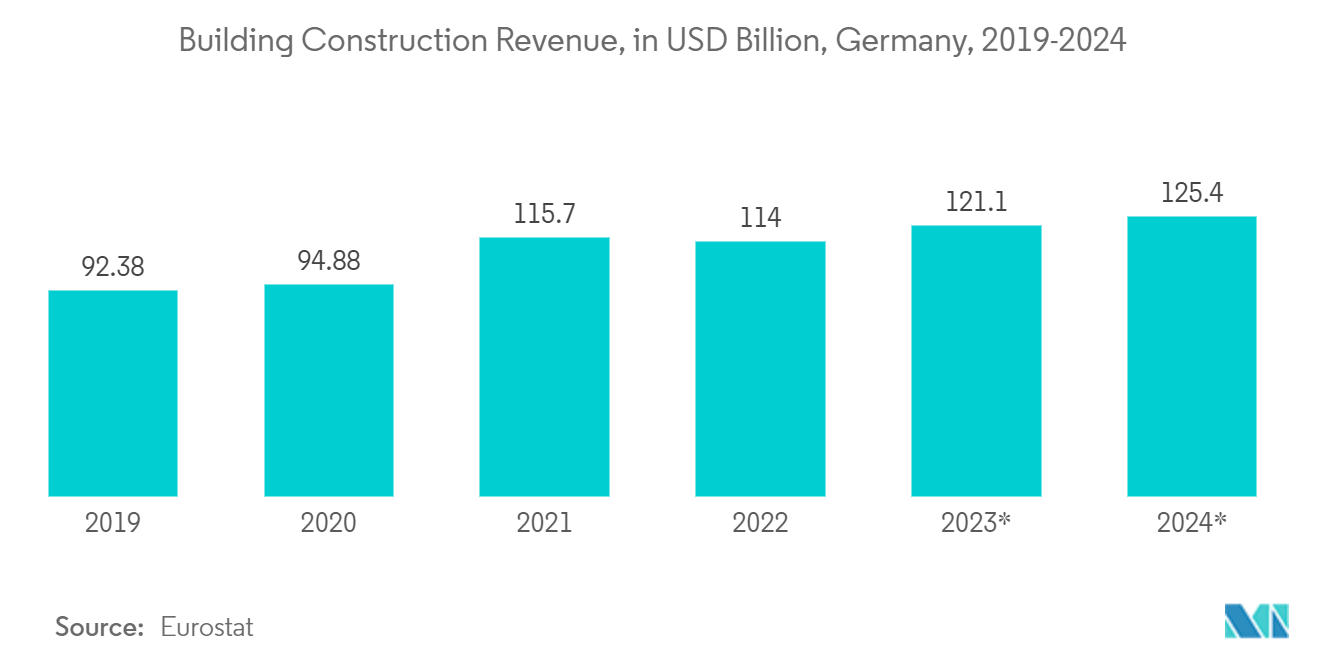
Competitive Landscape
Europe's pigments market is consolidated in nature. Some of the key players in the market (not in any particular order) include BASF SE, DIC Corporation, LANXESS, Merck KGaA, and The Chemours Company.
Europe Pigments Industry Leaders
-
BASF SE
-
DIC Corporation
-
LANXESS
-
Merck KGaA
-
The Chemours Company
- *Disclaimer: Major Players sorted in no particular order
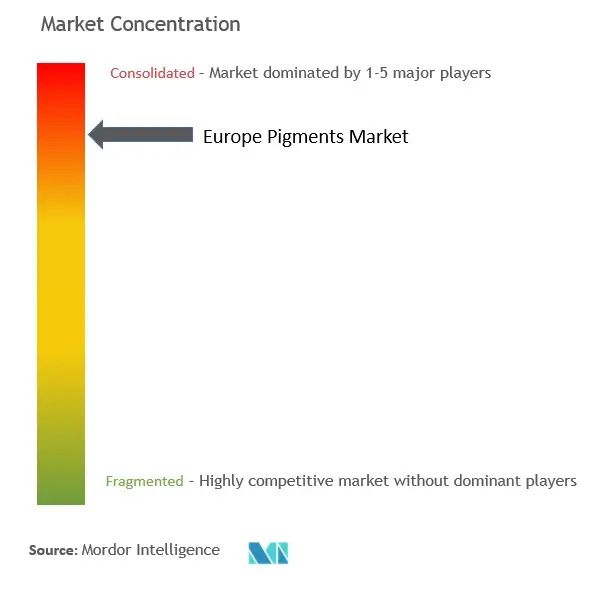
Recent Industry Developments
- November 2022: Cathay Industries announced the acquisition of the Iron Oxide Pigment business of Venator Materials PLC. The acquisition of Venator’s Iron Oxide Pigment business was expected to help Cathay Industries expand its global manufacturing footprint.
- January 2022: Clariant completed the sales of its pigments business to a consortium of Heubach Group and SK Capital Partner. Post completion of the deal, the Clariant company rolled over approximately CHF 115 million (USD 131.6 million) to retain a 20 % stake in the new holding company alongside Heubach and SK Capital.
Europe Pigments Market Report Scope
Pigments are molecules or substances that absorb specific wavelengths of visible light to produce a particular hue. Pigments can be found in paintings, inks, cosmetics, and other items. Pigments are found in various products and services associated with coloring materials and related technology. Pigments are used in various sectors, including coatings, plastics, printing inks, building, paper, leather, and cosmetics. Organic and inorganic pigments are available, with organic pigments being the most commonly used.
Europe's pigments market is segmented by product type, application, and geography. The market is segmented By product type into inorganic (titanium dioxide, zinc oxide, and other product types (iron oxide, Chromium Oxide, etc.)), organic, specialty pigments, and other product types (metallic pigments, natural pigments, etc.). By application, the market is segmented into paints and coatings, textiles, printing inks, plastics, leather, and other applications (cosmetics, ceramics, electronics, etc.).The report also covers the market size and forecasts for the pigments market in 4 countries in the region.
For each segment, the market sizing and forecasts are provided in terms of value (USD).
| Inorganic | Titanium Dioxide |
| Zinc Oxide | |
| Other Product Types (Iron Oxide, Chromium Oxide, etc.) | |
| Organic | |
| Specialty Pigments | |
| Other Product Types (Metallic Pigments, Natural Pigments, etc.) |
| Paints and Coatings |
| Textiles |
| Printing Inks |
| Plastics |
| Leather |
| Other Applications (Cosmetics, Ceramics, Electronics, etc.) |
| Europe | Germany |
| United Kinfdom | |
| France | |
| Italy | |
| Rest of Europe |
| Product Types | Inorganic | Titanium Dioxide |
| Zinc Oxide | ||
| Other Product Types (Iron Oxide, Chromium Oxide, etc.) | ||
| Organic | ||
| Specialty Pigments | ||
| Other Product Types (Metallic Pigments, Natural Pigments, etc.) | ||
| Application | Paints and Coatings | |
| Textiles | ||
| Printing Inks | ||
| Plastics | ||
| Leather | ||
| Other Applications (Cosmetics, Ceramics, Electronics, etc.) | ||
| Geography | Europe | Germany |
| United Kinfdom | ||
| France | ||
| Italy | ||
| Rest of Europe | ||
Key Questions Answered in the Report
How big is the Europe Pigments Market?
The Europe Pigments Market size is expected to reach USD 6.26 billion in 2025 and grow at a CAGR of greater than 4% to reach USD 7.62 billion by 2030.
What is the current Europe Pigments Market size?
In 2025, the Europe Pigments Market size is expected to reach USD 6.26 billion.
Who are the key players in Europe Pigments Market?
BASF SE, DIC Corporation, LANXESS, Merck KGaA and The Chemours Company are the major companies operating in the Europe Pigments Market.
What years does this Europe Pigments Market cover, and what was the market size in 2024?
In 2024, the Europe Pigments Market size was estimated at USD 6.01 billion. The report covers the Europe Pigments Market historical market size for years: 2019, 2020, 2021, 2022, 2023 and 2024. The report also forecasts the Europe Pigments Market size for years: 2025, 2026, 2027, 2028, 2029 and 2030.
Page last updated on:
Europe Pigments Market Report
Statistics for the 2025 Europe Pigments market share, size and revenue growth rate, created by Mordor Intelligence™ Industry Reports. Europe Pigments analysis includes a market forecast outlook for 2025 to 2030 and historical overview. Get a sample of this industry analysis as a free report PDF download.
